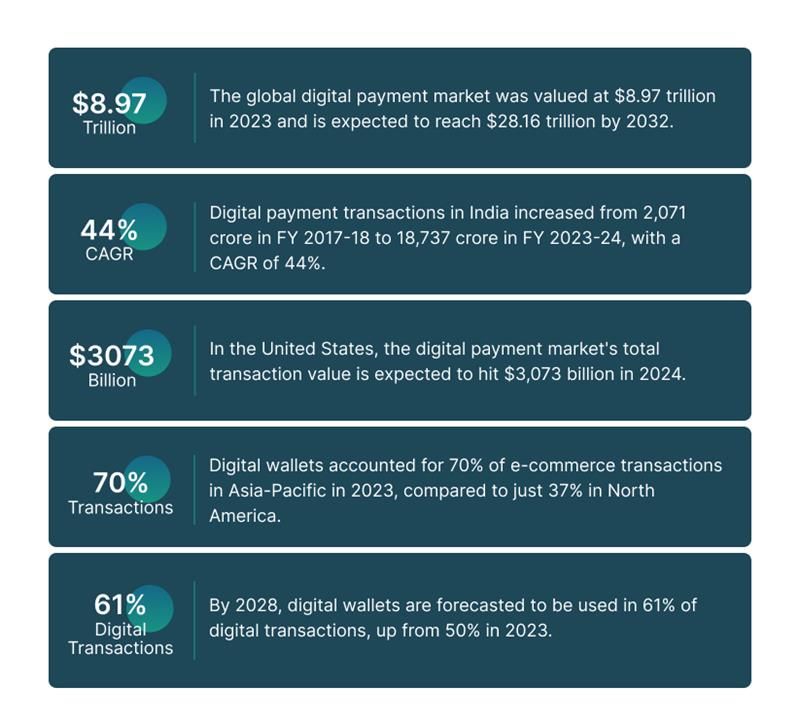Payment Reconciliation
How Payment Teams Can Keep Pace with the Surge in Digital Transactions
Uncover strategies and tools payment teams can use to manage growing digital transactions, streamline reconciliation, and enhance financial operations.

Amrit Mohanty
Dec 17, 2024 (Last Updated: Nov 14, 2025)

The digital payments landscape is changing at a historically unprecedented pace, driven by the most recent technological advancements, changing consumer behaviors, and increasing transaction volume. The global market for digital payments reached $8.97 trillion in 2023 and is anticipated to touch $28.16 trillion by 2032, representing a compound annual growth rate of 13.55% during this time period. Payment teams stand at the forefront of this revolution, tasked with adapting to rapid growth in digital transactions while keeping reconciliation efficient and financial operations robust. This blog post explores how payment teams can keep pace with this surge and the implications for reconciliation and financial operations.
The Digital Payments Surge: A Game Changer
Digital payments around the world have been quite spectacular. The market size is estimated at USD 96.07 billion in 2023, growing at a compound annual growth rate (CAGR) of 21.1% from 2024 to 2030. It is fueled by the growth of smartphone usage, enhanced internet accessibility, and shifting preferences towards cashless transactions. The COVID-19 pandemic has accelerated these factors. This also means that since the end of 2021, two-thirds of adults worldwide made some form of digital payment; more than this number is anticipated for the future years, hence showing a trend of rising digital financial solutions across a majority of regions.
Embracing Technological Innovations
Payment teams need to utilize innovative technologies to match the growth in digital transactions. The introduction of QR codes has greatly simplified payments across the world, mostly to the advantage of small merchants. For example, in the United States, 89 million smartphone users scanned QR codes in 2022, which is 26% more than in 2020. The increased usage has been mainly due to the demand for contactless payment solutions, especially after the COVID-19 pandemic. Such technologies can be adopted by payment teams to enhance customer experiences and operational efficiency. For instance, in the last few years, QR code scans have increased by 57% across 50 countries, which is a very strong global trend towards digital payments.

Data-Driven Insights
With more than 40% of all transactions becoming cashless, using data analytics becomes a crucial mode in understanding the points of transaction and consumer preferences. Transactional data can, therefore, guide some strategic decisions. For example, a report shows that globally cashless transactions per person rose yearly from 91 in 2017 to 135 in 2020, indicating a continuous rise towards digital payments in economies around the world. Analyzing peak hours can optimize staffing and resources during busy hours for such businesses to meet customers efficiently. The importance of leveraging data analytics is even more pronounced as the global digital payment market is projected to grow from $8.97 trillion in 2023 to $28.16 trillion by 2032.
Reconciliation Challenges: Navigating Complexity
As the volumes of transactions increase, so do the intricacies of reconciliation. Traditional techniques may not be sufficient enough and, hence, can lead to potential inaccuracies that affect financial reporting. For example, a recent study showed that 84% of payment firms in the UK and US are still depending on manual work and spreadsheets for reconciliation, which has a major flaw in terms of inefficiency. Payment teams have to implement automated reconciliation tools that can process high transaction volumes efficiently. These tools both eliminate manual errors and report on transaction status in a timely manner, allowing teams to be on top of discrepancies and ensure perfect records.
The Importance of Real-Time Monitoring
Real-time monitoring of transactions is the primary requirement for effective reconciliation. Payment teams should implement instant tracking systems that enable a quick identification of discrepancies on payments. Industry data reported that financial institutions using the real-time monitoring system decreased fraud losses by up to 50% compared with those using traditional methods. With real-time transaction monitoring, organizations can analyze more than 25 billion transactions per year, leveraging advanced analytics and machine learning to detect fraudulent activities as they occur. This proactive approach can significantly reduce the time spent on reconciliation processes and enhance overall financial operations.
Financial Operations: Adapting to New Norms
The rise in digital transactions requires a review of financial operations within organizations across the globe. Payment teams must ensure that their financial systems are equipped to handle increased transaction volumes while maintaining compliance with regulatory standards. This includes adapting to new business models that emerge from the digital payments ecosystem. For instance, the global digital payment market was estimated at USD 100.20 billion in 2023 and is expected to reach USD 464.28 billion by 2032, growing at a compound annual growth rate (CAGR) of 19.16% during this period. This huge growth in transaction volumes points out the pressing need for organizations to improve their financial operations to stay in step with such growth. As more and more consumers embrace digital payment methods, businesses must be flexible in their financial strategies and systems to remain competitive and compliant in this rapidly changing landscape.
Building Robust Partnerships
Collaboration with fintech companies can bring cutting-edge technologies and innovative solutions to the payment teams. As new players join the market, strategic partnerships can enhance operational capabilities and improve service offerings. For example, cross-border payments can open new revenue streams for businesses looking to expand globally. In fact, a recent survey showed that three out of four global banks are planning to connect with an average of three fintechs within the next 12-18 months, emphasizing the importance of these partnerships in modern financial strategies.
Empowering Small Businesses: A Catalyst for Growth
The growth in digital payments has significantly empowered small businesses globally through the removal of regional constraints and smooth transactions between different regions. For instance, in the United States alone, more than 50 percent of small businesses now operate with digital payment solutions, thereby portraying a significant shift from cash-based transactions to cashless. This shift not only brings about cash flow efficiency but also improves access to credit for small merchants. Hence, it integrates small merchants into the formal economy. A significant trend is rising usage of mobile wallets-60% of small businesses used mobile wallets for transactions in 2024-a sign of growing preference for secure and convenient payment. There is further potential for the global digital payments market, which will reach approximately $193.7 billion by 2028, especially with the increasing adoption of these technologies among SMEs.
Conclusion: Future-Proofing Payment Teams
The future of digital transactions continues to surge upward, and payment teams must be nimble and forward-thinking in response. To navigate the increasingly complex world of digital payments, these teams can employ technology, utilize data analytics, automate reconciliation processes, and leverage strategic partnerships. The prospects for digital payments are optimistic, but a concerted effort from all parties involved must be made. In this volatile environment, it is the role of payment teams to spearhead their organizations toward successful outcomes.
In summary, adapting to the surge in digital transactions involves not just keeping pace but also anticipating future trends and challenges. With robust strategies in place, payment teams can ensure their organizations thrive amidst this transformation.

